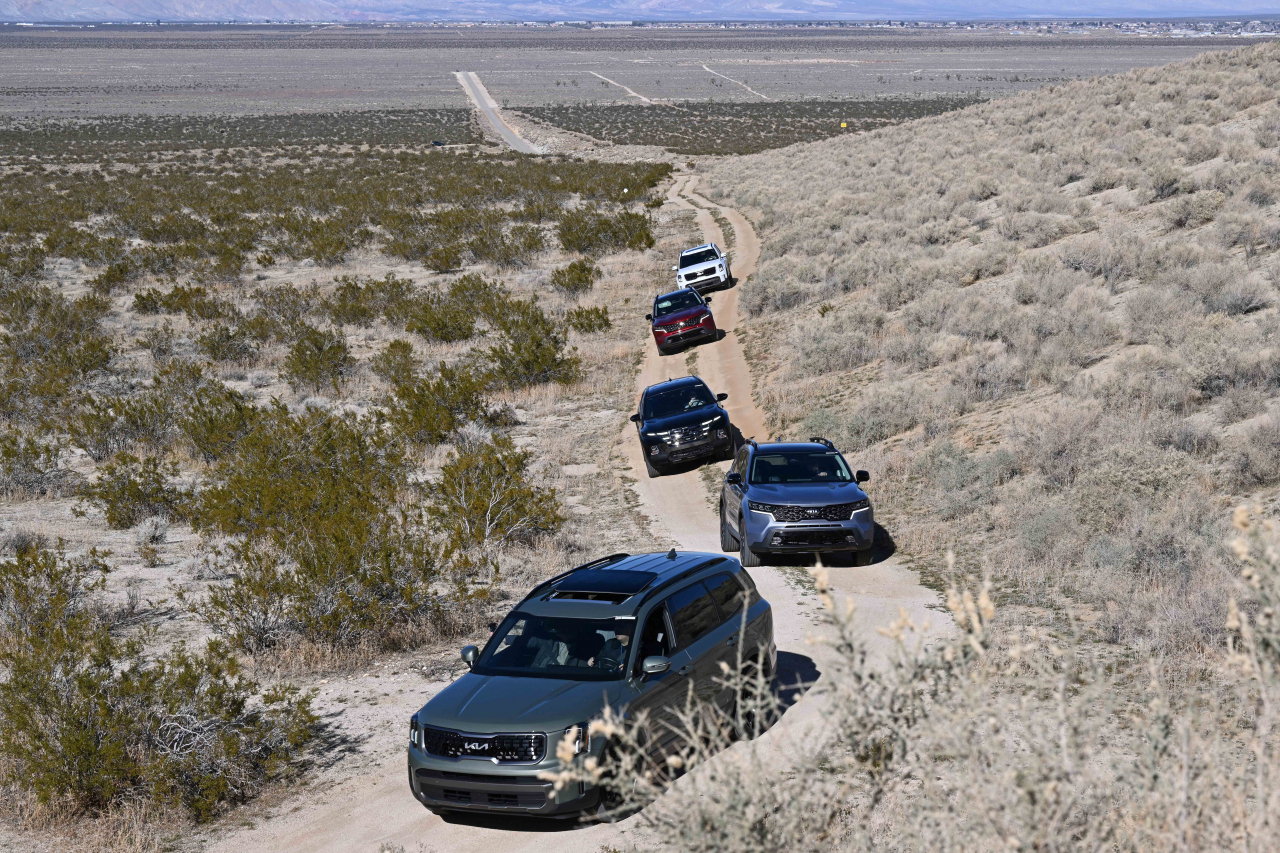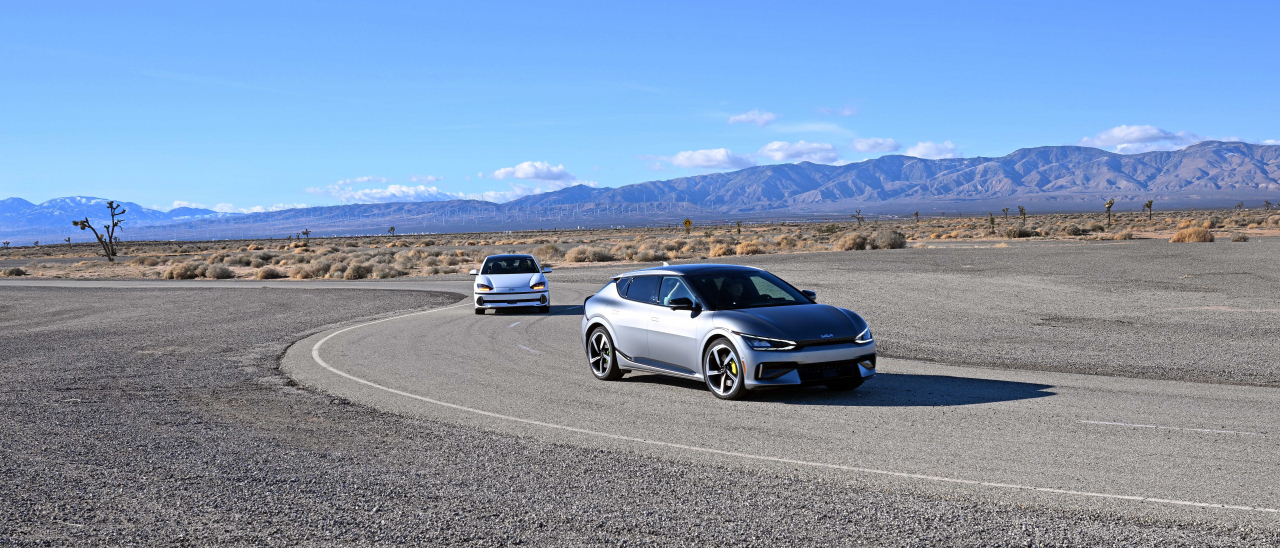 |
A convoy of Hyundai and Kia SUVs, led by the Kia Telluride, navigates the terrain of the California Proving Ground in the Mojave Desert. (Hyundai Motor Group) |
CALIFORNIA CITY, California -- If you want to know how Kia's Telluride SUV managed to rank among the top midsize sporty utility vehicles in the US market last year, or how Hyundai and Kia clinched second place in the US EV market behind Tesla following a record sales year, it’s worth taking a closer look at their California Proving Ground, the Korean carmakers’ extensive vehicle testing facility in the Mojave Desert.
“Our focus has evolved from primarily testing internal combustion engines in hot weather conditions to encompassing a wider range of tests for electric vehicles and rigorous off-road assessments for SUVs, all to better tailor these vehicles to the US market,” Kang Hee-jin, a principal testing researcher at Hyundai America Technical Center said during the Korea Herald's visit to the facility tour and a series of test drives last Thursday.
Covering a vast 17.7 million square kilometers, an area large enough to park nearly 1.8 million cars, the California Proving Ground is among the largest in the US, comparable only to those owned by global automakers like GM, Ford, and Toyota. It features an array of 12 test tracks, including seven off-road courses and a high-speed oval track stretching over 10.3 kilometers.
The proving ground reflects manifold off-road conditions in US, which differ significantly from the more predictable off-road environments in Korea. In US, off-road driving can encompass a wide array of terrains, and the California facility takes full advantage of the country's expansive landscapes and the harsh, dry desert climate. Annually, the site tests over 300 vehicles.
“We've significantly upgraded test tracks with a variety of off-road surfaces. It's all about beefing up our SUVs to take on any adventure our customers might want to try,” said Lee Kyung-jae from the chassis thermal performance test team.
 |
A Kia Telluride is put to the test on a steep, uneven dirt track at the 1.2-kilometer Traction Control System test course, for stability and off-road capabilities in challenging terrain. (Hyundai Motor Group) |
A prominent feature of the proving ground is the Traction Control System test course, a 1.2-kilometer track designed with varying slopes and challenging terrains, perfect for evaluating the off-road stability and control of SUVs like the Telluride.
A test drive of the vehicle by the Korea Herald showcased the vehicle's ability to navigate potholes smoothly, maintaining responsive steering and control despite significant body shake. The suspension effectively absorbed the impact, ensuring a smooth and surprisingly agile ride for a vehicle of its size.
The real-world driving conditions replicated at the site include tests on a variety of road surfaces, from sand and gravel to asphalt berms. During these tests, the Telluride maintained a reassuring level of control, performing quietly and comfortably.
The harsh desert climate of the proving ground is also valuable for testing electric vehicles, especially for thermal management trials.
“The Mojave Desert's scorching temperatures, averaging 39 degrees Celsius and reaching surface temperatures of up to 54 degrees Celsius in summer, are just what we need to push our EVs to the limit, especially when it comes to keeping their cool under extreme conditions,” Kang explained.
This challenging environment was crucial in developing Hyundai’s Ioniq 5N, a high-performance electric vehicle. A key goal was to keep the battery temperature below 60 degrees Celsius, even in the most demanding driving conditions.
Kang noted the unique challenges posed by electric vehicles, such as handling the additional weight from high-density batteries. “The suspension, tires, and body of an EV must withstand significantly higher loads than those in traditional internal combustion vehicles,” he said.
 |
A Kia EV6 GT speeds along the California Proving Ground's extensive track, part of a rigorous 48,000-kilometer durability test to simulate aging in the harsh Mojave Desert. (Hyundai Motor Group) |
Electric vehicles are put through over 4,000 laps on the 10.3-kilometer track, equating to roughly 48,000 kilometers, to simulate aging and ensure durability under stress.
Testing the EV6 GT, Kia’s high-performance electric SUV, on this circuit proved stable performance under extreme driving conditions. The vehicle's low center of gravity ensured precision cornering with minimal body roll, and the regenerative braking system demonstrated smooth and controlled stops, even from high speeds. The system's auto mode facilitated almost automatic braking, allowing for occasional single-pedal driving.
In addition to vehicle performance testing, the proving ground also featured a material environmental durability facility, which resembled a solar power plant. Essential components such as lidar sensors for assisted driving features, bumpers, headlamps, and paint samples, along with interior parts like crash pads, are subjected to the long-term effects of sun exposure.
“This facility enables us to accelerate durability testing up to 30 times faster than in other locations, making the most of the desert climate,” said Yoon Young-jun, head of the durability testing team.




![[Weekender] Korea's traditional sauce culture gains global recognition](http://res.heraldm.com/phpwas/restmb_idxmake.php?idx=644&simg=/content/image/2024/11/21/20241121050153_0.jpg)


